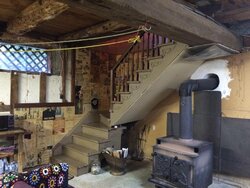Hi there,
A dealer told me yesterday that you don't measure your real heat space by simply adding each floor's square feet together, but by counting only half the space of the floors above the stove, considering that the heat is going up.
But then again, some other people told me that heat doesn't go up that easy, that you have to make it go up, and that your stove is never too big, etc.
My new house has a 840 sf area with the stove in the basement and two stories up, with the bedrooms upstairs. So I have around 2400 sf, but with the first idea in mind, i'd be okay with a 2000 sf stove, rather than a 2500-3000 sf.
I was aiming at Pacific Energy, going all the way with the Summit, but the Super 27 might be what I need.
Am I going wrong?
I'm kind of new to real wood-burning, and i'm moving by the end of october, in time for heat season, so I want to make the right move!
Thanks a lot.
A dealer told me yesterday that you don't measure your real heat space by simply adding each floor's square feet together, but by counting only half the space of the floors above the stove, considering that the heat is going up.
But then again, some other people told me that heat doesn't go up that easy, that you have to make it go up, and that your stove is never too big, etc.
My new house has a 840 sf area with the stove in the basement and two stories up, with the bedrooms upstairs. So I have around 2400 sf, but with the first idea in mind, i'd be okay with a 2000 sf stove, rather than a 2500-3000 sf.
I was aiming at Pacific Energy, going all the way with the Summit, but the Super 27 might be what I need.
Am I going wrong?
I'm kind of new to real wood-burning, and i'm moving by the end of october, in time for heat season, so I want to make the right move!
Thanks a lot.




